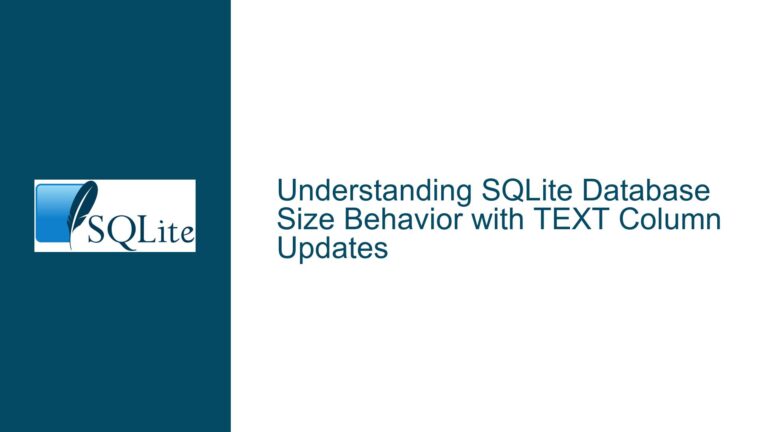Optimizing SQLite Query Performance for Large Dataset Searches
Slow Query Performance Due to Full Table Scans and Correlated Subqueries
The core issue revolves around a query that is performing poorly on a moderately large dataset in SQLite. The dataset consists of project records, with each project identified by a unique combination of a (project ID) and idate (insert date). The query aims to retrieve the latest entry for each project that matches a specific pattern in the b (project name) field. The original query uses a combination of a LIKE operator with a wildcard prefix and a correlated subquery to find the maximum idate for each project. This approach results in a full table scan and repeated subquery executions, leading to significant performance degradation.
The table t0 is structured with a composite primary key on (a, idate), and an additional index a_idate_idx on the same columns, which is redundant since the primary key already enforces uniqueness and provides an implicit index. The query performance is further hampered by the use of the LOWER function on the b field, which is unnecessary given that SQLite’s LIKE operator is case-insensitive by default.
The query in question is:
SELECT * FROM t0 as rec
WHERE rec.a IN
(
SELECT a FROM t0 WHERE 1=1
AND lower(rec.b) LIKE '%ioc-net%'
)
AND
rec.idate =
(SELECT MAX(idate) FROM t0 WHERE a = rec.a)
GROUP BY rec.a;
This query takes approximately 243 seconds to execute on a dataset of 56,984 records, which is unacceptable for daily reporting needs.
Inefficient Index Usage and Unnecessary Function Calls
The primary causes of the slow query performance are inefficient index usage, unnecessary function calls, and the structure of the query itself. The LIKE operator with a leading wildcard (%ioc-net%) necessitates a full table scan because SQLite cannot leverage an index to optimize the search. This is a fundamental limitation of B-tree indexes, which are not designed to handle prefix wildcards efficiently.
The use of the LOWER function on the b field is redundant because SQLite’s LIKE operator is already case-insensitive. This unnecessary function call adds computational overhead without providing any benefit. Additionally, the correlated subquery to find the maximum idate for each project requires SQLite to scan the table multiple times, once for each project ID that matches the LIKE condition.
The redundant index a_idate_idx on (a, idate) also contributes to inefficiency. Since the primary key already enforces uniqueness and provides an implicit index, creating an additional index on the same columns is redundant and wastes storage space. This redundancy can lead to increased maintenance overhead during data modifications, such as inserts, updates, and deletes.
Leveraging SQLite’s Min/Max Optimization and Query Restructuring
To address the performance issues, the query can be restructured to leverage SQLite’s min/max optimization and eliminate unnecessary function calls and correlated subqueries. The revised query avoids the need for a correlated subquery by using the MAX function directly in the SELECT clause, which allows SQLite to retrieve the latest idate for each project in a single pass.
The optimized query is:
SELECT a, b, c, d, e, max(idate) AS idate
FROM t0 AS rec
WHERE a IN (SELECT DISTINCT a FROM t0 WHERE b LIKE '%ioc-net%')
GROUP BY a;
This query performs the following steps:
- Generates a list of unique project IDs (
a) that match theLIKEcondition by scanning the table once. - For each project ID in the list, retrieves the latest record using the
MAX(idate)function, which SQLite optimizes by seeking directly to the last entry in the index for each group.
The execution time of the optimized query is significantly faster, completing in approximately 0.671 seconds compared to the original 243 seconds. This improvement is due to the elimination of the correlated subquery and the unnecessary LOWER function call, as well as the efficient use of the primary key index.
Detailed Explanation of the Optimized Query
The optimized query works by first identifying all unique project IDs that match the LIKE condition. This is achieved with the subquery:
SELECT DISTINCT a FROM t0 WHERE b LIKE '%ioc-net%'
This subquery scans the t0 table once to find all project IDs where the b field contains the substring "ioc-net". The DISTINCT keyword ensures that each project ID is listed only once, even if multiple records match the condition.
The outer query then uses this list of project IDs to retrieve the latest record for each project. The MAX(idate) function is used to find the most recent idate for each project ID, and the GROUP BY clause ensures that only one record per project is returned. SQLite’s min/max optimization allows it to efficiently retrieve the latest record for each project by seeking directly to the last entry in the index for each group, avoiding the need for additional scans or subqueries.
Additional Considerations for Query Optimization
While the optimized query provides a significant performance improvement, there are additional considerations that can further enhance query performance and maintainability:
Index Optimization: Although the primary key index is sufficient for most queries, consider creating additional indexes on frequently searched columns. For example, if the
bfield is often searched with a trailing wildcard (ioc-net%), an index onbcould improve performance for such queries.Data Normalization: The current table structure includes 56 fields, which may lead to redundancy and inefficiency. Normalizing the data by splitting it into multiple related tables can reduce storage requirements and improve query performance. For example, project metadata could be stored in a separate table and linked to the main table via a foreign key.
Query Caching: If the same query is executed frequently with the same parameters, consider caching the results to avoid repeated execution. SQLite does not natively support query caching, but application-level caching can be implemented to store and reuse query results.
Database Maintenance: Regularly running
VACUUMandANALYZEcommands can help maintain database performance.VACUUMreclaims storage space and defragments the database file, whileANALYZEupdates the statistics used by the query planner to make informed decisions about index usage.Query Plan Analysis: Use the
EXPLAIN QUERY PLANstatement to analyze the execution plan of your queries. This can provide insights into how SQLite is executing the query and identify potential bottlenecks. For example, if the query plan indicates a full table scan, consider adding or modifying indexes to improve performance.
Example of Query Plan Analysis
To analyze the execution plan of the optimized query, you can use the following command:
EXPLAIN QUERY PLAN
SELECT a, b, c, d, e, max(idate) AS idate
FROM t0 AS rec
WHERE a IN (SELECT DISTINCT a FROM t0 WHERE b LIKE '%ioc-net%')
GROUP BY a;
The output might look something like this:
QUERY PLAN
|--SCAN TABLE t0 AS rec
|--LIST SUBQUERY 1
| `--SCAN TABLE t0
`--USE TEMP B-TREE FOR GROUP BY
This indicates that SQLite is scanning the t0 table to find matching project IDs and then using a temporary B-tree to group the results. The absence of a full table scan in the outer query confirms that the optimization is effective.
Conclusion
By understanding the underlying causes of slow query performance and leveraging SQLite’s optimization features, it is possible to significantly improve the efficiency of database queries. The key takeaways from this analysis are:
- Avoid unnecessary function calls and redundant indexes.
- Use SQLite’s min/max optimization to eliminate correlated subqueries.
- Regularly analyze and optimize your database schema and queries to maintain performance.
Implementing these best practices will ensure that your SQLite database remains responsive and efficient, even as the dataset grows and query complexity increases.






